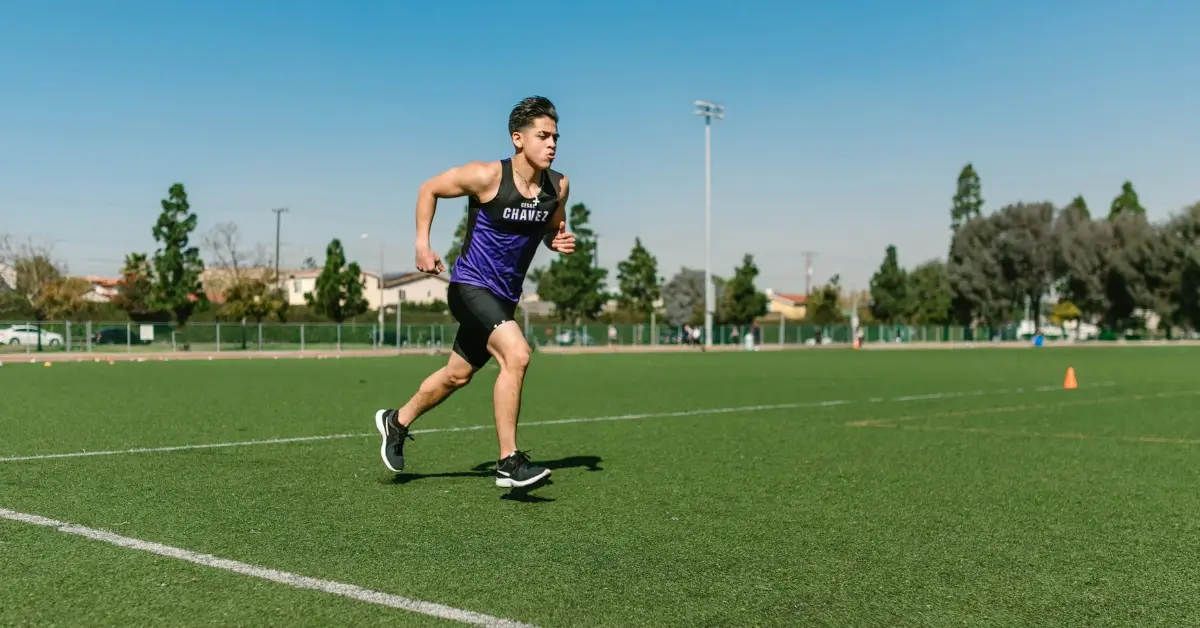CrossFit workouts are designed to challenge our overall fitness, incorporating a wide range of exercises and movements. One particular exercise that has gained popularity within the community is the CrossFit shuttle run. This high-intensity movement is not only fun to perform, but it also greatly enhances our speed, endurance, and agility.
Shuttle runs are an incredibly versatile exercise that can be modified to suit various fitness levels and goals. The movement involves sprinting back and forth between two points within a predefined distance, such as 10 or 20 yards. In CrossFit shuttle runs are often incorporated into workouts as a fast-paced and demanding cardio component.
Pro´s:
- ✅ Quick & Easy Set Up
- ✅ Shatterproof
- ✅ Weather-Resistant
Con:
- ❌ You have to set it up and take it down
Understanding Shuttle Runs
😊 Basics of Shuttle Runs
Typically, you’ll set up two cones or markers at a specific distance apart and sprint from one cone to the other, making a sharp change in direction as you touch down on each cone. Your pace will vary depending on the specific aerobic or anaerobic effort required for the workout, with an optimal range of 7 to 9 steps between each marker.
Here’s a basic outline of a shuttle run:
- ✅ Set up the course by placing two cones or markers at the desired distance apart.
- ✅ Warm up with some light stretching and jogging to prepare your body for the workout.
- ✅ Start the run by sprinting from one cone to the other, maintaining your desired pace and steps.
- ✅ Repeat the process as many times as specified in your workout.
- ✅ Cool down afterwards with more stretching to help you recover.
😃 Benefits of CrossFit Shuttle Runs
Incorporating CrossFit shuttle runs into your workout can yield many benefits. Primarily, it helps improve your cardio and agility, making you a more well-rounded athlete.
Here are some specific advantages of shuttle runs:
- ✅ Cardiovascular endurance: Shuttle runs are an intense aerobic and anaerobic workout, helping to increase your cardiovascular endurance and stamina.
- ✅ Speed and agility: The quick change in direction required for shuttle runs can improve your speed, coordination, and balance, essential skills for many athletic pursuits.
- ✅ Power and strength: As your hamstrings, glutes, and calves propel you during the runs, shuttle runs help develop lower body power and strength.
- ✅ Calorie burn: Due to their high-intensity nature, shuttle runs contribute to an elevated calorie burn during your workout.
- ✅ Athletic performance: Overall, incorporating shuttle runs into your CrossFit routine can boost your athletic performance across various disciplines.
CrossFit Shuttle Run Specifics

In this section, we’ll dive into the specifics of the CrossFit shuttle run, a popular exercise in CrossFit workouts and the CrossFit Open. We’ll explore its connection to the CrossFit Open and its movement standards.
🏃♂️ CrossFit Open and Shuttle Run
The CrossFit Open is an annual worldwide fitness competition where athletes from all levels participate and test their fitness capacities. The shuttle run is one of the exercises often incorporated and can play a key role in determining an athlete’s overall scorecard.
Tip: Remember to warm up properly before performing shuttle runs to prevent injury and maximize results.
📏 Movement Standards
One rep consists of starting at point A, sprinting to point B, touching the ground with both feet and one hand, and running back to point A. The specific distance between points A and B, such as 10 or 20 yards, should be predetermined and maintained throughout the exercise.
Here’s a quick guide to setting up your CrossFit shuttle run course:
- ✅ Choose two points: Mark the start and end (point A and point B) with a distance you’re comfortable with.
- ✅ Use cones or markers: Clearly mark the points to ensure accuracy during the exercise.
By adhering to these movement standards, we can effectively participate in CrossFit shuttle run workouts.
Workout Integration

😊 Incorporating CrossFit Shuttle Runs
One way to integrate shuttle runs into our workouts is by incorporating interval training. This involves alternating between high-intensity shuttle sprints and short periods of rest or low-intensity recovery exercises.
Here’s an example of a workout that combines shuttle runs and interval training:
- ✅ Warm-up: Jog 5 minutes, followed by dynamic stretches.
- ✅ Shuttle run sprints: Set up two cones 25 meters apart.
- ✅ Sprint between the cones, touching the ground with one hand at each cone.
- ✅ Repeat for a total of 5 reps.
- ✅ Rest 1 minute.
- ✅ Core exercise of choice: Complete 1 minute (e.g., plank, Russian twists).
- ✅ Rest 1 minute.
- ✅ Repeat steps 4-7 for a total of 5 rounds.
Incorporating CrossFit shuttle runs into our training regimen can help us track our progress, as we’ll be able to see improvements in our times and overall fitness level as we practice.
😊 Developing Agility with Cone Drills
Cone drills are another great way to enhance our agility and help us become more versatile athletes.
For example, let’s consider a cone drill workout that also includes agility ladder drills:
- ✅ Set up cones for shuttle runs (25-50 meters apart).
- ✅ Perform agility ladder drills for 5-10 minutes.
- ✅ Complete 10 shuttle sprints between the cones, maintaining proper form and intensity.
- ✅ Rest 1-2 minutes.
- ✅ Repeat steps 2-4 for a total of 3-5 rounds.
Execution Techniques

🏃♂️ Proper Form and Movement
- ✅ Set up two cones 10 to 25 meters apart for the shuttle run.
- ✅ Sprint from one cone to the other, focusing on maintaining straight body alignment and efficient footwork.
- ✅ Make rapid transitions in direction to enhance performance.
- ✅ When turning, stay on the balls of the feet for quicker turns and better control.
- ✅ Keep feet close together while changing direction to minimize the risk of slipping or losing balance.
- ✅ Lean the body slightly inward during turns to take advantage of momentum.
🔄 Efficiency and Technique
To optimize efficiency and technique during CrossFit shuttle runs, we should focus on several key elements:
- ✅ Pacing: Determining a sustainable pace will help us perform consistently throughout the workout. It’s essential to align our pace with the specific aerobic or anaerobic effort required.
- ✅ Turns: Executing effective turns can significantly impact our performance. Practice quick turns and changes in direction to enhance our agility.
- ✅ Acceleration and Deceleration: To improve our explosiveness, we should focus on accelerating quickly at the start of each sprint and decelerating effectively while approaching the turns.
- ✅ Change of Direction Drills: Incorporating change of direction drills into our training regime will benefit our overall agility, making us more adaptable for various movements in CrossFit workouts.
Training and Progression
🏃♂️ Starting with Basic Exercises
When beginning CrossFit shuttle run training, it’s crucial to start with basic exercises that help build strength in our legs, along with improving cardiovascular endurance.
We recommend the following basic exercises to build foundational strength:
- ✅ Squats: Start with 3 sets of 10 reps, increasing as needed. Squats target our glutes and quads, essential muscles for shuttle runs.
- ✅ Calf Raises: Perform 3 sets of 15 reps. Calf raises help strengthen our calves, providing stability during shuttle run movements.
- ✅ Lunges: Try 3 sets of 10 reps for each leg. Lunges target our hamstrings and glutes for improved lower-body strength.
Remember to time each workout with a stopwatch or timer, and gradually increase the intensity as our fitness level improves.
🔥 Advancing to Complex Drills
Once we feel confident in our basic exercises, advancing to more complex drills allows us to further challenge our bodies and improve performance on the CrossFit Shuttle Run.
Some popular advanced drills we can use to progress our training include:
- ✅ The T Test: Typically used by the NFL, this drill involves running forwards, sideways, and backwards in a T-shaped pattern. Complete the test three times and record our best time to gauge improvement.
- ✅ Intervals: Perform shuttle runs for a set number of minutes or seconds, followed by a rest period, then repeat. Increase the work and rest periods as we progress, always tracking our progress.
- ✅ Ladder Drills: Arrange cones or other markers at increasing distances. Sprint to the first marker, touch it, sprint back to the start, then sprint to the second marker, touching it, and return to the start. Continue this pattern for each marker.
Safety and Injury Prevention

🤸 Warm-Up Routines
Proper warm-up routines are essential for our safety and injury prevention during CrossFit shuttle runs.
A well-rounded warm-up should include dynamic stretches that focus on our muscle groups such as hamstrings, quads, calves, and hip flexors. Light aerobic exercises, like jumping jacks or high knees, can also kick-start our heart rate and improve circulation.
A quick sample warm-up routine for shuttle runs could be:
- ✅ 5 minutes of light aerobic exercises (e.g., jogging, jumping jacks)
- ✅ Leg swings – 10 each leg
- ✅ Arm circles – 10 forward and 10 backward
- ✅ Hip circles – 10 clockwise and 10 counterclockwise
- ✅ High knees – 20 total (10 each leg)
Remember to pay attention to maintaining balance and stability during our stretches and movements.
🧘♀️Post-Workout Recovery
After completing our CrossFit shuttle runs, it is crucial for us to properly cool down and recover. Engaging in post-workout recovery can help prevent injuries and promote long-term health.
A few post-workout recovery tips include:
- ✅ Perform static stretches that target the major muscle groups we used during the exercise, such as hamstrings, quads, and hip flexors. Hold each stretch for 15 to 30 seconds.
- ✅ Use a foam roller or other self-myofascial release tools to ease tightness in our muscles.
- ✅ Hydrate and consume a balanced meal or snack to replenish the nutrients and energy our body needs to recover.
- ✅ Prioritize rest and ensure we get adequate sleep to support our body’s natural recovery process.
Best tips to maximize your recovery and enjoyment: Post Run Feeling.
Performance Measurement
When it comes to CrossFit shuttle run, understanding and analyzing an athlete’s performance is essential. In this section, we’ll discuss various methods of measuring performance, including the use of timers and scorecards, as well as analyzing the collected data.
🚦 Using Timers and Scorecards
Since the CrossFit shuttle run test measures an athlete’s speed, agility, and cardiorespiratory fitness, we need to track the time taken for each run accurately. Typically, a stopwatch or a digital timer is used for this task.
Alongside timing, a scorecard serves as a convenient tool for recording each athlete’s performance. A well-designed scorecard should include:
- ✅ Athlete’s name
- ✅ Date of the test
- ✅ Number of completed runs
- ✅ Time taken for each run
With these details recorded, we can effectively compare the performance of various athletes and track their improvements over time.
📊 Analyzing Performance Data
Once we’ve collected our performance data using timers and scorecards, it’s time to analyze it to gain insights into an athlete’s strengths and areas needing improvement.
To do this, we might consider examining various factors such as:
- ✅ Comparing times: Analyze the time taken to complete each CrossFit shuttle run to identify patterns in the athlete’s performance. Are they consistently fast, or do they struggle to maintain a steady pace?
- ✅ Examining progress: Compare the athletes’ scores over time to assess their improvement. Are their speed, agility, and endurance improving gradually?
- ✅ Performance against peers: Study how an athlete’s performance compares to that of their peers. This can be valuable for identifying areas where the athlete excels and needs fine-tuning.
- ✅ Identifying weaknesses: By examining the data, we can identify the specific aspects of shuttle runs that the athlete is struggling with, such as maintaining momentum or powering through turns.
Nutrition and Hydration

Maintaining proper nutrition and hydration is crucial for athletes, especially in a demanding exercise like the CrossFit shuttle run.
🏃♂️ Diet for Endurance
To support our aerobic and anaerobic capabilities during CrossFit shuttle runs, we need to consume a diet that focuses on:
- ✅ Carbohydrates: These are the primary fuel source for our muscles during high-intensity workouts. Aim to include complex carbohydrates such as whole grains, fruits, and vegetables in your diet. They provide a steady supply of energy and help prevent sudden dips in performance. For example, oatmeal with egg whites and almonds.
- ✅ Protein: Essential for muscle repair and growth. Including lean protein sources like chicken, fish, tofu, or low-fat dairy products will ensure we get the required amino acids for muscle recovery.
- ✅ Fats: Healthy fats like avocado, nuts, and olive oil help us maintain our energy levels during longer aerobic exercises. They also promote overall health by supporting hormone production, joint health, and brain function.
It’s also important to monitor calorie intake, as CrossFit shuttle runs can significantly increase the calorie burn during a workout session. Adjust your calories to ensure you’re maintaining a balance between energy intake and expenditure.
💧 Hydration Strategies
Staying properly hydrated is critical in maintaining optimal performance during workouts.
Here are some tips to effectively manage hydration:
- ✅ Monitor urine color: A light yellow color indicates proper hydration. A darker color could signal the need to increase fluid intake.
- ✅ Before a workout: Consume 16-20 ounces of water 2-3 hours prior to exercise, and another 7-10 ounces 20-30 minutes before starting.
- ✅ During exercise: Aim to drink 7-10 ounces of water every 10-20 minutes. For extended workouts, consider including an electrolyte-enhanced sports drink.
- ✅ After exercise: Replenish lost fluids by consuming 20-24 ounces of water for every pound lost during the workout.
CrossFit Community and Teamwork
One of the many things that make CrossFit unique is the strong sense of community and teamwork. In this section, we’ll discuss the different ways teamwork and camaraderie come into play, focusing on the CrossFit Shuttle Run.
🏋️♂️ Individual vs. Team Drills
There are two main types of CrossFit Shuttle Runs: individual and team-based.
Individual Shuttle Runs: Participants sprint between two points, touching the ground with both feet and one hand at point B before returning to the starting point. This helps improve cardiovascular endurance, speed, and agility.
Team-based Shuttle Runs: Participants take turns sprinting between points A and B, passing a baton or making physical contact to signal the next teammate to start. This fosters cooperation, collaboration, physical fitness, teamwork, and communication.
🤝 Community Events and Challenges
Many CrossFit gyms organize community events and challenges, often incorporating the shuttle run. These events bring together athletes of all levels, from beginners to elite competitors.
Some examples of such events are:
- ✅ CrossFit competitions: These events typically feature multiple workouts, with the shuttle run often included as a way to test athletes’ speed and endurance.
- ✅ Charity fundraisers: CrossFit gyms often host workouts or events in support of local charities. incorporating the shuttle run can add an element of fun and teamwork to these fundraisers.
- ✅ CrossFit Open: The annual CrossFit Open is an opportunity for athletes worldwide to participate in challenging workouts, including the shuttle run. Participating in the Open as part of a team can be a great way to build camaraderie within the larger CrossFit community.
Incorporating the CrossFit Shuttle Run into team-based and community events not only provides physical benefits but also helps to foster the strong sense of community that CrossFit is known for.
Our Opinion on Crossfit Shuttle Run
In our opinion, the CrossFit Shuttle Run is an excellent high-intensity exercise that can significantly improve an athlete’s cardiovascular endurance, speed, and agility. It combines sprinting and squats, making it a versatile addition to any CrossFit routine.


Here’s why we like the CrossFit Shuttle Run:
- Cardiovascular endurance: The fast-paced nature of this workout helps boost our heart rate, improving overall cardiovascular endurance.
- Speed: Practicing shuttle runs can assist in increasing our sprinting speed, which can translate to better performance in various sports and activities.
- Agility: Incorporating quick turns, we can become more agile and better equipped to handle sudden changes in direction, vital in many sports.


When incorporating the CrossFit Shuttle Run into your routine, remember these tips:
- Determine your pace: Ensure it aligns with a specific aerobic or anaerobic effort requirement.
- Count your steps: Strive to maintain an optimal step range, approximately 7 steps.
- Execute effective turns: Practice efficient and smooth pivots to save time and strength.
FAQ
What is the proper technique for the shuttle run?
The proper technique for the shuttle run involves optimizing turns, footwork, and hand usage to improve efficiency. It’s important to maintain an upright posture with a slight forward lean to the torso during acceleration, along with knowing the distance and steps required for the run.
How can I improve my speed and endurance for the shuttle run?
To enhance speed and endurance for the shuttle run, you can incorporate sprint workouts, agility drills, and jumping exercises into your training routine. Additionally, focusing on building lower body strength and practicing rapid changes in direction can significantly improve your performance.
What are the benefits of incorporating shuttle runs into my CrossFit training routine?
Incorporating shuttle runs into your CrossFit training routine offers numerous benefits, including improved cardiovascular endurance, agility, and speed. It also provides a high-intensity interval training workout, contributing to overall fitness and athletic performance.
What is your option on CrossFit Shuttle Run? I would love to hear it in the comments. I’m sure you also like reading about How long to wait after eating to run or Slow Jogging vs Fast Walking.



